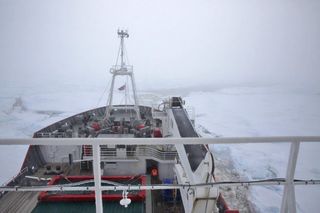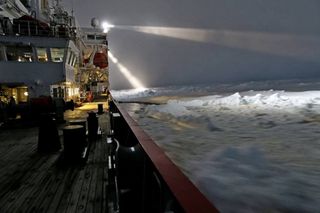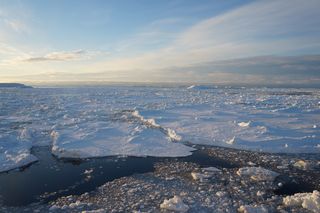In Photos: Research Vessel Headed to 'Hidden' Antarctic Ecosystem
Sea ice

Heavy sea ice in Antarctica’s Weddell Sea forced the British polar research vessel RRS James Clark Ross to turn back from their destination near the Larsen C ice-shelf on the east coast of the Antarctic Peninsula, the British Antarctic Survey (BAS) announced March 2, 2018.
The ship was carrying an international team of scientists who had hoped to survey the area recently exposed along the ice shelf by the giant A-68 iceberg that broke off from Antarctica's Larsen C Ice Shelf in July 2017. [Read more about the Antarctic expedition]
Destination ahead

The scientists on board the RRS James Clark Ross were more than 250 miles (400 kilometers) from their destination beside the southern Larsen C Ice Shelf when the ship was forced to turn north.
Slow Going

The heavy ice in the Weddell Sea meant that the RRS James Clark Ross has only been able to cover a few miles each day.
There are only a few weeks left in the short Antarctic summer, so the ship's captain made the "difficult decision" to head for a new destination, near the Larsen A region of the Antarctic Peninsula.
RRS James Clark Ross

The RRS James Clark Ross is a marine research and supply ship operated by the British Antarctic Survey since the 1990s.
It also supports British scientific research in the Arctic regions during the Antarctic winters.
James Clark Ross

The ship is named after the 19th-century naval officer and polar explorer James Clark Ross.
Between 1839 and 1843, Ross commanded a British expedition to Antarctica on the ships HMS Erebus and HMS Terror, which charted much of the coastline of the frozen continent.
Equipped for work

The RRS James Clark Ross is equipped with several scientific laboratories and winch systems for deploying scientific equipment into the water.
Deep ice

Although the ship is designed to break through with sea ice up to 3 feet (1 meter) thick, it was forced to turn back after encountering ice of up to 16 feet (5 m) thick in the Weddell Sea.
Sign up for the Live Science daily newsletter now
Get the world’s most fascinating discoveries delivered straight to your inbox.
Antarctic ice ship

The international team of scientists on board the RSS James Clark Ross had hoped to be the first to survey a newly exposed area of the seafloor beside the Larsen C Ice Shelf.
A giant iceberg, dubbed A-68, started breaking away from the edge of the ice-shelf in 2014.
Big 'ole iceberg

Last year, the A-68 iceberg, covering an area of more than 2,000 square miles, broke free from the ice shelf and started to float away.
Scientists say the seafloor exposed by the A-68 iceberg has been covered by the thick ice shelf for around 120,000 years.
Next stop

The RRS James Clark Ross and the international team of scientists on board will now head farther north on the Antarctic Peninsula, to carry out a marine survey near the Larsen A ice region.
The next scientific expedition to Larsen C is scheduled in early 2019, on a German research ship, RV Polarstern.
Tom Metcalfe is a freelance journalist and regular Live Science contributor who is based in London in the United Kingdom. Tom writes mainly about science, space, archaeology, the Earth and the oceans. He has also written for the BBC, NBC News, National Geographic, Scientific American, Air & Space, and many others.
